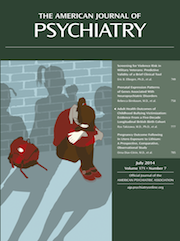Electroconvulsive Therapy is a Standard Treatment; Ketamine is Not (Yet)
To The Editor: Alan Schatzberg’s commentary in the March issue, “A Word to the Wise About Ketamine” (1), urges caution in the clinical use of ketamine pending further research and data collection. We agree with this position and would like to share our clinical experience with seriously depressed patients who have received ketamine infusions prior to electroconvulsive therapy (ECT) referral. In the last year, we have seen at least half a dozen patients who, when they presented for ECT consultation, gave histories of having had either single or repeated ketamine infusions at a private anesthesiologist’s office in New York City. These patients had either no, or very transient, antidepressant benefit from the ketamine or unpleasant adverse effects (mainly dissociative); they were subsequently referred by their psychiatrists for consideration of ECT. Most of these patients were profoundly depressed, and some were suicidal. If a ketamine challenge is to become a standard step in the treatment algorithm for treatment-resistant depression, the risks of not just the ketamine itself, but the delay in definitive treatment, must be taken into account.
Seriously depressed patients who have failed to respond to one or more antidepressant medication trials should be referred for ECT consultation, sooner rather than later, to ensure optimal outcomes. Suicide risk in this population is elevated, as is the potential for ongoing medical morbidity, not to mention the continued suffering from the depressive episode itself. A recent study (2) comparing three ketamine infusions with three ECT treatments in 1 week touted ketamine as a superior treatment and received considerable media attention (3). A reasonable interpretation of that research is that it replicated the finding of a signal of early antidepressant response with ketamine. However, ketamine remains completely unproven as a definitive treatment for a major depressive episode. Seriously ill psychiatric patients are often desperate for dramatic cures; their health care providers, acknowledging that our current treatments are often lacking, are also eager for the newest breakthroughs. Such desperation and enthusiasm should not cloud our clinical judgment; proven, evidence-based treatments, including ECT for seriously depressed patients, should be offered before unproven, experimental approaches, no matter how “in vogue” those approaches may be.
1 : A word to the wise about ketamine. Am J Psychiatry 2014; 171:262–264Link, Google Scholar
2 : Rapid antidepressant effects of repeated doses of ketamine compared with electroconvulsive therapy in hospitalized patients with major depressive disorder. Psychiatry Res 2014; 215:355–361Crossref, Medline, Google Scholar
3 : Ketamine outperforms ECT in depression study. Psychiatr News, Jan 2014, p 17Google Scholar



